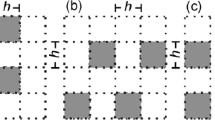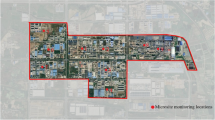Abstract
In previous wind environmental studies, the consideration of newly built high-rise residential building clusters and comparison of influences of different architectural parameters were relatively primitive. This study aimed to visualize and analyse wind environments of typical high-rise residential building clusters in developing regions. It investigated the influences of unit numbers, transverse distances, longitudinal distances and staggered distances of building clusters. A methodology integrated by parametric modelling, CFD simulation and image processing was developed to evaluate 39 representative scattered configuration cases. The findings can be summarized as follows: (1) For building clusters with relatively large numbers of building units, the increase in longitudinal distance has relatively limited ventilation promotion effect. (2) It was recommended to increase transverse distance for ventilation promotion in building clusters with numerous units. (3) Though an increase in staggered distance can promote wind flow among building units, the total influence and the low-velocity area on the leeward side increase at the same time. (4) Low-velocity area in the wake is directly proportional to the windward projective area of the entire building cluster. The study contributes original knowledge to urban wind environments and benefits sustainable design of high-rise residential communities.
Graphical abstract
















Similar content being viewed by others
References
Ai ZT, Mak CM, Niu JL (2014) Numerical investigation of wind-induced airflow and interunit dispersion characteristics in multistory residential buildings. Indoor Air 23(5):417–429
Aynsley RM (1989) Politics of pedestrian level urban wind control. Build Environ 24(4):291–295
Aynsley RM (1999) Shape and flow: the essence of architectural aerodynamics. Archit Sci Rev 42(2):69–74
Bentham T, Britter R (2003) Spatially averaged flow within obstacle arrays. Atmos Environ 37(15):2037–2043
Bhatnagar A (2006) Environmental cardiology: studying mechanistic links between pollution and heart disease. Circ Res 99(7):692–705
Blocken B, Carmeliet J (2004) Pedestrian wind environment around buildings: literature review and practical examples. J Building Phys 280402(107):1097–1963
Blocken B, Stathopoulos T, Carmeliet J (2007) CFD simulation of the atmospheric boundary layer: wall function problems. Atmos Environ 41(2):238–252. https://doi.org/10.1016/j.atmosenv.2006.08.019
Brown MJ, Lawson RE, Decroix DS, Lee RL (2001) Comparison of centerline velocity measurement obtained around 2D and 3D building array in a wind tunnel. In: Proceeding of the 2001 international symposium on environmental hydraulics
Buccolieri R, Sandberg M, Sabatino SD (2010) City breathability and its link to pollutant concentration distribution within urban-like geometries. Atmos Environ 44(2010):1894–1903
Chang JC, Hanna SR (2004) Air quality model performance evaluation. Meteorol Atmos Phys 87(1–3):167–196
Cheung JOP, Liu CH (2011) CFD simulations of natural ventilation behaviour in high-rise buildings in regular and staggered arrangements at various spacings. Energy Build 43(5):1149–1158
Cochran L (2004) Design features to change and/or ameliorate pedestrian wind conditions. In: Structures 2004: building on the past, securing the future, Nashville, Tennessee, ASCE/SEI Structure Congress. p 1–8.
Du YX, Mak CM, Tang BS (2018) Effects of building height and porosity on pedestrian level wind comfort in a high-density urban built environment. Build Simul 11(6):1215–1228
Efthimiou G, Santiago J, Martilli A (2011) Cost 732 in practice: the must model evaluation exercise
Franke J, Hellsten A, Schlünzen H, Carissimo B (2007) Best Practice Guideline for the CFD Simulation of Flows in the Urban Environment. COST Office, Hamburg
Freitas JS, Cronemberger J, Soares RM, Amorim CND (2020) Modeling and assessing BIPV envelopes using parametric Rhinoceros plugins Grasshopper and Ladybug. Renew Energy 160:1468–1479. https://doi.org/10.1016/j.renene.2020.05.137
Hang J, Li Y (2011) Age of air and air exchange efficiency in high-rise urban areas and its link to pollutant dilution. Atmos Environ 45(31):5572–5585
He Y, Schnabel MA, Mei Y (2019) A novel methodology for architectural wind environment study by integrating CFD simulation, multiple parametric tools and evaluation criteria. Build Simul 8:1–17. https://doi.org/10.1007/s12273-019-0591-8
He Y, Schnabel MA, Chen R Wang N (2017) A parametric analysis process for daylight illuminance-the influence of perforated facade panels on the indoor illuminance. Janssen P, Raonic P Loh A, Schnabel MA (eds) Protocols, Flows, and Glitches-Proceedings of the 22nd CAADRIA Conference. Xi'an Jiaotong-Liverpool University, Suzhou, China, p 417–424. https://doi.org/10.52842/conf.caadria.2017.417
Iqbal QMZ, Chan ALS (2016) Pedestrian level wind environment assessment around group of high-rise cross-shaped buildings: effect of building shape, separation and orientation. Build Environ 101(5):45–63
Krishan A, Baker N, Yannas S, Szokolay S (2001) Climate Responsive Architecture: a design handbook for energy efficient buildings. Tata McGraw-Hill Pub. Com Limited, Mumbai
Kubota T, Miura M, Tominaga Y, Mochida A (2008) Wind tunnel tests on the relationship between building density and pedestrian-level wind velocity: development of guidelines for realizing acceptable wind environment in residential neighborhoods. Build Environ 43(10):1699–1708. https://doi.org/10.1016/j.buildenv.2007.10.015
Lam CKG, Bremhorst K (1981) A modified form of the k-epsilon model for predicting wall turbulence. ASME J Fluids Eng 1034(3):456–460. https://doi.org/10.1115/1.3240815
Launder BE, Spalding DB (1974) The numerical computation of turbulent flows. Comput Methods Appl Mech Eng 3:269–289
Luo W, Dong Z, Qian G, Lu J (2012) Wind tunnel simulation of the three-dimensional airflow patterns behind cuboid obstacles at different angles of wind incidence, and their significance for the formation of sand shadows. Geomorphology 139–140:258–270. https://doi.org/10.1016/j.geomorph.2011.10.027
Mavroidis I, Griffiths RF (2001) Local characteristics of atmospheric dispersion within building arrays. Atmos Environ 35(16):2941–2954. https://doi.org/10.1016/s1352-2310(00)00456-8
Mei S, Hu J, Liu D, Zhao F, Li Y, Wang Y, Wang H (2017) Wind driven natural ventilation in the idealized building block arrays with multiple urban morphologies and unique package building density. Energy and Build 155:324–338
Middel A, Häb K, Brazel AJ, Martin CA, Guhathakurta S (2014) Impact of urban form and design on mid-afternoon microclimate in phoenix local climate zones. Landsc Urban Plan 122:16–28
Rhinoceros 3D (2018) 1993–2022 Robert McNeel & Associates. Available from https://www.rhino3d.com/
Richardson LF (1911) The approximate arithmetical solution by finite differences of physical problems involving differential equations, with an application to the stresses in a masonry dam. Philos Trans R Soc London Series A Contain Pap Math Phys Character 210:307–357
Richards PJ, Hoxey RP (1993) Appropriate boundary conditions for computational wind engineering models using the k-ε turbulence model. J Wind Eng Indus Aerodyn 46:145–153
Roache PJ (1994) Perspective: a method for uniform reporting of grid refinement studies. Trans ASME J Fluids Eng 116(3):405–413
Schneider CA, Rasband WS, Eliceiri KW (2012) NIH image to ImageJ: 25 years of image analysis. Nat Methods 9(7):671–675
Sobachkin A, Dumnov G (2014) Numerical Basis of CAD-Embedded CFD White Paper
Stathopoulos T, Baskaran BA (1996) Computer simulation of wind environmental conditions around buildings. Eng Struct 18(11):876–885
Toparlar Y, Blocken B, Maiheu B, Van Heijst GJF (2017) A review on the CFD analysis of urban microclimate. Renew Sustain Energy Rev 80:1613–1640
Tsang CW, Kwok KCS, Hitchcock PA (2012) Wind tunnel study of pedestrian level wind environment around tall buildings: effects of building dimensions, separation and podium. Build Environ 49:167–181. https://doi.org/10.1016/j.buildenv.2011.08.014
Vinchurkar S, Longest PW (2008) Evaluation of hexahedral, prismatic and hybrid mesh styles for simulating respiratory aerosol dynamics. Comput Fluids 37(3):317–331
Wilks D (2006) Statistical Methods in the Atmospheric Sciences, 2nd edn. Academic Press, Cambridge
Zhu CL, Wei HY, Long H (2011) Design Theories of Residential Architecture. China Architecture & Building Press, Beijing
Acknowledgements
The authors would gratefully acknowledge the financial supports of the Natural Science Foundation of China (NSFC Grant No. 52078264).
Author information
Authors and Affiliations
Corresponding author
Additional information
Publisher's Note
Springer Nature remains neutral with regard to jurisdictional claims in published maps and institutional affiliations.
Rights and permissions
Springer Nature or its licensor (e.g. a society or other partner) holds exclusive rights to this article under a publishing agreement with the author(s) or other rightsholder(s); author self-archiving of the accepted manuscript version of this article is solely governed by the terms of such publishing agreement and applicable law.
About this article
Cite this article
He, Y., Chu, Y., Song, Y. et al. Visualization and metrics analysis of wind environments of typical high-rise residential building cluster configurations using CFD and image processing. J Vis 26, 1211–1232 (2023). https://doi.org/10.1007/s12650-023-00931-5
Received:
Revised:
Accepted:
Published:
Issue Date:
DOI: https://doi.org/10.1007/s12650-023-00931-5




